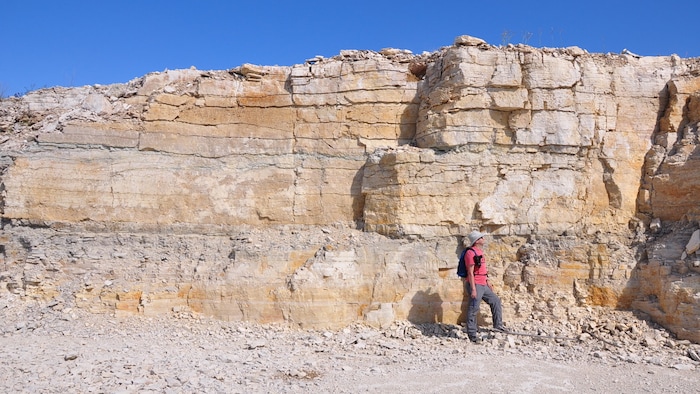Open full screen Colin Sproat stands near a quarry wall north of The Pas, Manitoba, one of the places where researchers found evidence of an ancient tsunami. Radio-Canada Speech synthesis, based on artificial intelligence, makes it possible to generate spoken text from written text. Researchers from the University from Saskatchewan Brian Pratt and Colin Sproat have made an astonishing discovery: a tsunami may have occurred on the Prairies hundreds of millions of years ago. This discovery is surprising because it is difficult to find coastal views or seismic activity in Saskatchewan and surrounding areas today. However, the landscape was very different 445 million years ago. Much of Saskatchewan, Manitoba, Montana, and South and North Dakota was covered by a sea known as the Williston Basin. At the time we were much closer to the equator than today and sea levels were high. We would have been in a shallow, tropical inland sea rather than a temperate grassland like today, says Colin Sproat, associate professor in the department of geological sciences at the University of Saskatchewan.
Colin Sproat and Brian Pratt are researchers at the University of Saskatchewan.
Brian Pratt and Colin Sproat visited three locations north of The Pas, Manitoba, where they observed that strata had been broken into pieces and mixed with the clay.
According to them, clay can only come from dry land and a tsunami.
Loading
Ex-judge Jacques Delisle guilty of manslaughter
ELSEWHERE ON INFO: Former judge Jacques Delisle guilty of manslaughterLoading in progress
Former judge Jacques Delisle guilty of manslaughter
ELSELSE ON INFO: Former judge Jacques Delisle guilty of manslaughter
In an interview on the radio show Saskatoon Morning,University of Saskatchewan geological sciences professor Brian Pratt explains that faults in the region's crust were still active at the time. The movement of a fault would have triggered strong waves in the inland sea.
The coastal line and shallow waters were swept by wave trains. [The tsunami] would then have swept the coastal area, he says, adding that the tsunami would then have retreated, taking the clay with it.
The tsunami hypothesis is a radical interpretation of the facts, as Brian Pratt recognizes.
He explains that he and his colleague had an advantage over the geologists who worked before them, as over the past decade several new quarries have been dug in northern Manitoba, revealing new secrets about the Williston Basin.
Deposits similar to those observed by the researchers could in principle have been formed by major storms.
Brian Pratt and Colin Sproat, however, ruled out this hypothesis, as there were no other signs indicating regular thunderstorm activity.
Additionally, they believe the area was too close to ancient Ecuador to have experienced hurricanes.
Colin Sproat believes that these discoveries are a unique chance to study the geological processes in an environment that does not exist anywhere else on the planet today.
Researchers are also planning ;go visit other places in Canada to see if tsunamis played a more important role in Earth's history.
With information from Candice Lipski

